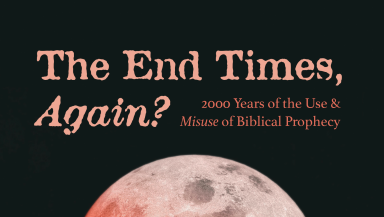
In June 2016, I organized a meeting, under the banner of the local council of churches, to discuss issues relating to the forthcoming EU referendum. The meeting was intended to provide an opportunity for airing Christian views on the subject. It was well attended and drew in participants from across the wide denominational spectrum of churches.
A rather surprising meeting – or not!
The evening was lively. Many of my friends (regardless of whether they were Leave or Remain) expressed astonishment afterwards at the way the discussion developed.
They had expected the topics to include debates over things like: sovereignty and parliamentary accountability; jobs and economic prosperity; continent-wide cooperation in order to meet global challenges; peace and security in Europe.
What they got was: whether the EU parliament building in Strasbourg was modelled on the Tower of Babel; the accusation that the statue of 'Europa and the Bull' in the European district of Brussels reveals the pagan origins of the EU; the allegation that the seat 666 is kept empty in the European Parliament chamber in both Brussels and Strasbourg (it isn't); discussion over whether the EU represents the final political structure arising from the four beasts/kingdoms prophesied in Daniel, and also referred to as the "beast rising out of the sea, having ten horns and seven heads" in Revelation; and whether it was a political tool of the Antichrist in advance of the second coming of Christ.
My friends were astonished at this. I wasn't. During the previous month I had contributed a guest blog for a Christian news platform. It had been entitled: "I Believe in Prophecy. But the EU Is Not Babylon the Great." During that month it had become, from my calculations, one of the most visited blogs on this website.
It can still be read online but, unfortunately, the huge string of comments and conversations under it can no longer be accessed. That is a pity because they would have provided interesting source material for future students of theology and the sociology of religion. Like the meeting I organized later, in June of that year, the online discussion got lively. In fact, it got very lively indeed! Some might say 'heated.'
However, when it comes to end-times speculation I 'have a past, as they say.
A bit of backstory
In 1975, as an impressionable 16-year-old, I avidly devoured the book 'The Late, Great Planet Earth,' written by Hal Lindsey, with Carole C. Carlson. It had been published in 1970, but took five years to cross my radar. Guided by Lindsey and Carlson, I explored chapters of Daniel, Ezekiel, and Revelation that I had never read before; and had certainly never heard addressed by a preacher in my church.
I became familiar with kingdoms with four phases and a beast with ten horns and seven heads. I learned of the role of the communist USSR (and China) in end-times events; and I discovered tribes called Gog, Magog, Meshech, and Tubal and their invasion of Israel in the last days and how they represented the (then-communist) Warsaw Pact states. I was introduced to a future end-times battle at a place called Armageddon and its geographical location in northern Israel. The book alleged that the EEC/EU was the prophesied successor to the fourth kingdom of Daniel 7, and also represented the ten-horned beast of Revelation 13. It was not an isolated publication.
In 1976, I caused waves in my comprehensive school when I led a school assembly and shared my views of the world and the nearness of the apocalypse. The only reason I was allowed to do any other assemblies after that was because I was a senior prefect, a national champion 400m runner, and a speedy winger in the First Fifteen rugby team. All of which helped my teachers overlook my (then) rather-radicalized millenarian views. Plus, they could not get any other senior students to volunteer to lead assemblies.
For me personally, what challenged the mindset that the 1970s literature had fostered was experience and historical study. The EEC/EU grew to its tenth member, yet the Antichrist did not appear. A further challenge to my earlier views arose from one of my degree special subjects at Bristol University: religion and politics. In 1980, I completed my dissertation on radical millenarians of the 17th century. They were also convinced that they were living in the last days.
I realized we had been here before. This accompanied the realization that, despite clear scriptural injunctions not to indulge in speculation regarding the timing of the second coming of Christ, this theme had occurred again and again over two thousand years, with only the targets changing. It also became increasingly clear that the way in which end-times prophecies were used often revealed more about the contemporary political and cultural preoccupations of some Christians than they did about eschatological events.
In my 35-year career as a secondary school teacher I developed an interest in early medieval history and came upon the same familiar end-times viewpoints. However, this time it was not the EU, or the papacy, or Oliver Cromwell, but the Viking hordes of the tenth century who presaged the last days. Other contemporary chroniclers saw signs of it in the Magyar invasions of the same period.
These experiences caused me to write a book which explored the history of end-times beliefs published in October 2021 under the title of 'The End Times, Again? 2000 Years of the Use and Misuse of Biblical Prophecy.'
Prophetic foundations
Christianity inherited from Judaism a deeply ingrained belief in prophecy. While one can argue that this more often involved 'forth-telling' than 'fore-telling,' it is clear that this also included the profound belief that history is moving towards a divinely-decided future date when God will judge the world, his rule will be established on earth, and the present created order will be transformed and renewed.
Jesus spoke of this future event and it was clearly an integral part of his message. His preferred self-identifier was 'Son of Man,' which was clearly based on Daniel chapter 7 and the idea of cosmic transformation. Eschatology (end times) belief is hard-wired into the gospels. There is, though, huge debate among modern biblical experts concerning what Jesus believed about this and its imminence. This is explored in the book.
Early Christians believed that Jesus would come again. The belief in the second coming informs key parts of the gospels, the letters and (in complex and dramatic form) the book of Revelation. In Revelation, this became closely associated with the idea of the 'millennium' –

Christ would establish a thousand-year reign on earth before the final judgement and the creation of a new heaven and earth. Much ink would later be spilled over whether Christ would come at the start or end of the millennium, and debates also occurred in the early Church, and continue to divide Christians, over how much of Revelation was aimed at historic first-century events and how much at future end-times actions; or whether it had multiple meanings (something often considered in the study of prophetic texts).
We also see increasing reflection on the role of the Antichrist (the personification of opposition to Christ). It should be noted that the actual term "antichrist" (usually uncapitalised) is found in the New Testament five times in 1 John and 2 John, once in plural form and four times in the singular. The wording of these particular references means that they can be interpreted as marking out a certain category of persons, rather than an individual.
Later belief in an individual Antichrist figure, also draws on 2 Thessalonians. Here the term "antichrist" is not actually used and the terms found here are "the lawless one" and "the one destined for destruction" (2 Thess. 2:3 and 8). This person was later conflated with a singular 'Antichrist' and the fourth beast of Daniel 7.
The composite figure of the (singular) Antichrist has been, and is, often combined by Christian writers with figures found in the book of Revelation, such as one of the beasts of Revelation 13. The enigmatic number of the beast is given in Revelation 13:18 as six hundred and sixty-six (666). Consequently, the ideas of Antichrist, the blasphemous beasts, and the number 666 have become inextricably mixed.
However, in the New Testament, the actual matter is much more complex and it is far from clear whether these distinct figures were regarded as being aspects of one end-times enemy of Christ and his elect. It is a reminder of how prophecy is complex but interpretation tends towards combination and simplification; at times it can, arguably, even be a distortion of what was originally intended to be understood.
Early Christians thought these dramatic events would happen soon and began to get anxious when it did not occur within the first generation of the Church. We find answers to these anxieties in some of the letters of the New Testament.
What is clear is that there was and is what one might call a creative-tension between the Christian hope in the second coming and scriptural warnings that nobody knows the time it will occur (for example: Matthew 24:36, Acts 1:7). This should have given pause for thought among believers then and since. But it hasn't. I have even come across (rather rogue) commentators who read "But about that day and hour no one knows, neither the angels of heaven, nor the Son, but only the Father" (Matthew 24:36) and suggested that this made it ok to speculate about the year!
History at a glance
It is not possible to do justice to the dramatic and extraordinary history of Christian eschatology over 2,000 years in a short article, but I will give it a try! The book, of course, explores the matter in more detail.
An outlook developed over the first four centuries of the Christian era, which can broadly be described by the terms 'covenant theology,' 'supersessionism,' and 'replacement theology.' This held that the new covenant, based on faith in Jesus, replaced (or superseded) the old covenant, between God and the Jews. According to this understanding, the Christian Church replaced the Jews as the people of God and inherited what was promised to them. As well as meaning that Jews were no longer regarded as having a role within salvation history, it also accompanied the reading of prophetic scripture as symbolic and allegorical. By the end of the Roman Empire in the West, the end-times mood (as represented in official statements) had changed significantly. Literal and predictive interpretation of prophecy – once the dominant orthodoxy in the Church – increasingly became associated with fringe movements, even with heresy.
This did not stop people from speculating. Commentators named barbarian invaders as representing those foretold in prophecy; most notably the Magyars and the Vikings. End-times excitement and anxiety mounted as the Year 1,000 approached (despite the fact that an error in calculating the dating system meant it was not actually 1,000 years since the birth of Jesus). This accelerated during the crusades, when the armies of Islam were confidently identified as end-times actors. Some crusaders gave vent to their eschatological beliefs by butchering Jews in Rhineland cities, whom they claimed to be 'enemies of Christ' in this end-times conflict. Some indulged in forced conversions which, they said, fulfilled prophecy.
During the Middle Ages, rival popes and anti-popes, kings and emperors quarried prophetic scripture for accusations to throw at each other (usually the accusation of being the Antichrist). The background to the famous novel, 'The Name of the Rose,' is a bitter conflict between some renegade Franciscans and the papacy over end-times beliefs that led the former to armed rebellions against those regarded as agents of the Antichrist.
During the Reformation, Protestants overturned the established Catholic view of prophecy as allegorical and were sure they lived in the 'last days' – with the pope being the Antichrist. Violent Anabaptist groups established 'New Jerusalems' in anticipation of the second coming. Many thousands died in these bloody insurrections. As Britain spiralled into civil wars in the 1640s, eschatological excitement was intense. Cromwell addressed parliament in 1653 with the words: "You are at the edge of promises and prophecies." He also believed that the conversion of the Jews would precede the second coming and allowed the first presence of Jews in England since their expulsion in 1290.
One revolutionary group in England chose the year 1657 as the date of the second coming as it was three-and-a-half literal years since the start of the Protectorate (linked to 1,260 days found in Revelation and a similar number in Daniel). This identification labelled Cromwell as "the beast" (of Revelation) or the "little horn" (of Daniel), since clearly this could no longer be applied to the defeated (and executed) Charles I. Calculations arbitrarily switched between literal and symbolic readings of scriptural time-periods.
Things went rather quiet, when Puritan hopes collapsed at the Restoration of the Stuart monarchy in 1660. However, in North America the Puritan eschatological outlook encouraged eighteenth-century patriots to see George III as "the great Whore of Babylon," riding the "great red dragon" upon America (references to Revelation).
The nineteenth century saw hugely important developments in the study of prophecy which shifted the contemporary interpretation of prophecy from 'postmillennialism' (Christ will appear after the prophesied millennium) to 'premillennialism' (Christ will first appear and then instigate the millennium). This was closely related to the belief in the 'pre-tribulation rapture' and belief in the related, but different, 'dispensations' of the Jews and the Church. This envisaged the supernatural removal of the Church (and the end of the 'Church Dispensation') before the 'Great Tribulation' and the re-starting of the 'Jewish Dispensation' (suspended at the beginning of the 'Church Age') which would eventually lead to the conversion of the Jews.
Despite much that is said to the contrary, the idea of the 'pre-tribulation rapture' was, arguably, a radical departure from what had been believed for centuries about the second coming. However, this innovation is now mainstream. These ideas became closely associated with the writings of John Nelson Darby and were popularised (especially in the US) by the publication of the 'Scofield Reference Bible' in 1909. The recent 'Left Behind' series of novels embody this interpretation. They were produced by the writing team of Tim LaHaye and Jerry B. Jenkins and have sold somewhere in the region of eighty million copies!
In the twentieth century, the establishment of the State of Israel and the Cold War galvanized prophetic study, with many Christians identifying Israel as a fulfilment of end-times prophecy, while seeing the USSR and its allies as representing the tribal enemies of Israel in apocalyptic Old Testament prophecies.
For some, this outlook justified opposition to nuclear disarmament, since these weapons were seen as fulfilling predictions concerning widespread destruction, fire and sickness.
The collapse of the USSR shook one of these pillars of belief. However, belief in Israel as an end-times state remains a major part of modern evangelical eschatological thinking. Polling in the US in 2017 revealed that 80% of evangelicals believe that the creation of Israel in 1948 was a fulfilment of biblical prophecy that will bring about Christ's second coming. President Trump's decision to move the US embassy to Jerusalem in 2018 and to support Israeli sovereignty over the Golan Heights in 2019 was designed, not to appeal to American Jews, but to American evangelical Christians.
Continued attacks on the EU as a 'revived Roman Empire' and fulfilment of prophecy found in Daniel, seem to have overlooked how a 10-nation empire can be represented by a 27-nation body. As in the past, a lot of eschatological speculation seems as much grounded in contemporary political outlook and ideology as in biblical exegesis.
Since 2020, the Covid-19 pandemic has led to claims that it has eschatological significance. It should be noted that the same thing was said about the fourteenth-century Black Death. Anti-vaxxers and those unhappy with mask-wearing have included some who loudly identify these as aspects of an emerging Antichrist international order. This has resonated with – and been amplified by – conspiracy theory culture and the effects of social media algorithms.
The 'end times' are very much 'now times' across large areas of the Christian Church.
Where should we go from here?
Since I firmly believe in the second coming of Christ, but also believe that the Church record of getting it wrong is demonstrably alarming, how should we approach this subject to try to avoid the errors of the past? Here are my personal thoughts.
First, leave the timing to God and focus on kingdom-building. We may, or may not, be living in the end times. But we are always living in the time of evangelism for Christ. That is the priority.
Second, be confident in the hope of a new heaven and earth, while being active on the earth we currently have. Eschatology is not a reason for passivity or pessimism.
Third, a current crisis does not necessarily signal the end times.
Fourth, because something is prophesied does not remove it from the scrutiny of gospel standards. The return of Israel to 'the land' certainly appears to be fulfilment of prophecy. However, Christian support for Israel should never become unquestioning. Gospel standards apply to every nation. The Old Testament prophets never offered unquestioning support to the nation of their day. Real friends of Israel will lovingly point out when it gets things wrong.
Fifth, eschatology is not the preserve of any one part of the political spectrum. Today it is often associated with right-wing ideology and Christian nationalism. I believe that these ideologies are distorting it. However, the belief started with a marginalised and powerless group of radicals, who put their hope in God for transformation.
Sixth, admit when we get things wrong. The track record of large areas of the Church has been to follow up errors by doing more of the same. That is not a great strategy.
Martyn Whittock is an evangelical and a Licensed Lay Minister in the Church of England. As an historian and author, or co-author, of fifty-three books, his work covers a wide range of historical and theological themes. In addition, as a commentator and columnist, he has written for a number of print and online news platforms; has been interviewed on radio shows exploring the interaction of faith and politics; and appeared on Sky News discussing political events in the USA. The recently-published exploration of 2000 years of end-times thinking is: The End Times, Again? 2000 Years of the Use and Misuse of Biblical Prophecy (published by Wipf and Stock, Eugene, Oregon, USA, 2021).













